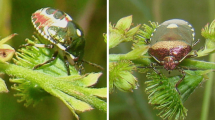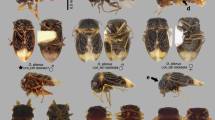Abstract
This paper is the second communication in a series of papers that treats the structure of the aedeagus in the family Pentatomidae and its taxonomic applications. Inner structures of the aedeagus were examined in the completely inflated state. The structure of the aedeagus was studied on 25 species. It is impossible to offer a diagnosis of the subfamily Podopinae on the basis of the structure of the aedeagus only, because this structure is very diverse. Nevertheless, some distinguishing characters were found in each of the three tribes, currently recognized within the subfamily. On the basis of the structure of the aedeagus, the tribe Graphosomatini can be subdivided into four groups, partly corresponding to the previously recognized tribes Graphosomatini (sensu Puchkov, 1965), Ancyrosomatini, and Trigonosmatini. Three different types of the structure of the aedeagus were revealed in the tribe Podopini. Special types of the structure of the aedeagus were found in the genera Bolbocoris and Testrica with unclear taxonomic position.
Similar content being viewed by others
References
Davidová-Vilimová, J. and Štys, P., “Diversity and Variation of Trichobothrial Patterns in Adult Podopinae (Heteroptera, Pentatomidae)”, Acta Univ. Carolinae 33, 33–72 [1993 (1994)].
Davidova-Vilimova, J. and McPherson, J.E., “History of the Higher Classification of the Subfamily Podopinae (Heteroptera, Pentatomidae), a Historical Review,” Acta Univ. Carolinae 38, 99–144 [1994 (1995)].
Gapon, D., “Inflation of Heteropteran Aedeagi Using Microcapillaries (Heteroptera, Pentatomidae),” Zoosyst. Ross. 9(1), 157–160 [2000 (2001)].
Gapon, D.A., “On the Taxonomic Position of the Tribe Procleticini Pennington (Heteroptera: Pentatomidae),” Kavkaz. Entomol. Bull. 1(1), 4–18 (2005).
Gapud, V.P., “A Generic Revision of the Subfamily Asopinae, with Consideration of its Phylogenetic Position in the Family Pentatomidae and Superfamily Pentatomoidea (Hemiptera-Heteroptera): Parts 1, 2,” Philippine Entomologist 8(1), 865–961 (1991).
Gross, G.F., Handbook of the Flora and Fauna of South Australia. Plant-Feeding and Other Bugs (Hemiptera) of South Australia. Heteroptera: Part 1 (Adelaide, Handbooks Committee, South Australian Government, 1975).
Leston, D., “The Wing Venation, Male Genitalia and Spermatheca of Podops inuncta (F.) with a Note on the Diagnosis of the Subfamily Podopinae Dallas (Hem. Pentatomidae),” J. Soc. British Entomol. 4, 129–135 (1953).
McDonald, F.J., “The Genitalia of North American Pentatomoidea (Hemiptera: Heteroptera),” Quaest. Entomol. 2, 7–150 (1966).
Puchkov, G.V. Shield Bugs of Middle Asia (Ilim, Frunze, 1966) [in Russian].
Schuh, R.T. and Slater, J.A. True Bugs of the World (Hemiptera: Heteroptera): Classification and Natural History (Cornell University Press, Ithaca, 1995).
Author information
Authors and Affiliations
Additional information
Original Russian Text © D. A. Gapon, F. V. Konstantionv, 2006, published in Entomologicheskoe Obozrenie, 2006, Vol. 85, No. 1, pp. 13–34.
Rights and permissions
About this article
Cite this article
Gapon, D.A., Konstantinov, F.V. On the structure of the aedeagus in shield bugs (Heteroptera, Pentatomidae): II. Subfamily Podopinae. Entmol. Rev. 86, 149–167 (2006). https://doi.org/10.1134/S0013873806020047
Received:
Issue Date:
DOI: https://doi.org/10.1134/S0013873806020047




